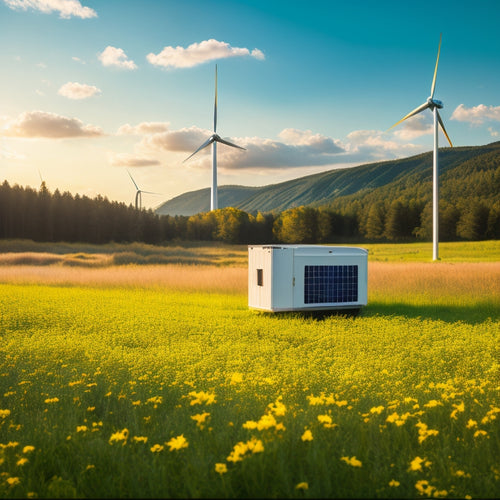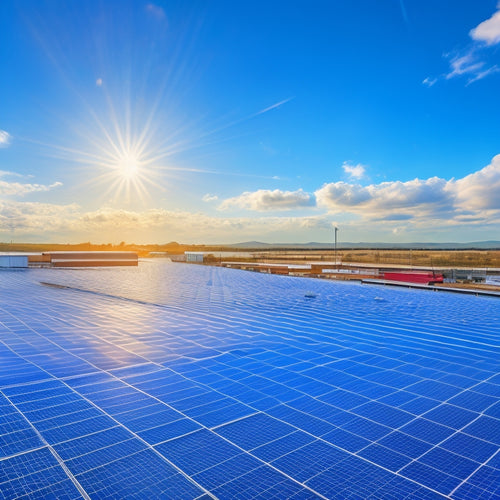
What You Need for Home Energy Independence
Share
To achieve home energy independence, you'll need to integrate several vital components. Start by selecting a suitable solar power backup system that guarantees a steady energy flow during low sunlight or grid outages. Next, choose the right battery capacity and chemistry based on your energy usage patterns and solar array size. Compatible solar panels with peak efficiency and temperature coefficient are also significant. Additionally, you'll need an inverter and charge controller that match your system's power requirements. Proper system sizing, installation, and safety protocols are also essential. By understanding these key elements, you'll be well on your way to achieving reliable home energy independence and revealing long-term savings and sustainability.
Key Takeaways
- A solar power backup system with a compatible inverter and charge controller ensures a steady energy flow during low sunlight or grid outages.
- Assessing power requirements and choosing the right battery capacity and chemistry is crucial for maintaining consistent energy supply and increasing overall efficiency.
- Selecting compatible solar panels with optimal efficiency, temperature coefficient, and peak power rating is essential for power generation and installation costs.
- Proper system sizing and installation, including consideration of energy requirements and roofing structure, ensures a safe and efficient energy backup system.
- Ongoing monitoring and maintenance, including regular checks and upgrades, are necessary to optimize performance, extend equipment lifespan, and ensure energy independence.
Understanding Solar Power Backup Systems
Considering the increasing popularity of solar power systems, having a reliable backup plan is essential to guarantee a steady flow of energy during periods of low sunlight or power grid outages.
You'll want to verify that your solar power system can provide a consistent supply of energy, even when the sun isn't shining. This is where solar power backup systems come in, which store excess energy for later use during outages or low sunlight, enhancing energy independence and reducing reliance on fossil fuels.
As you investigate the solar power benefits, you'll find that these systems are critical to maintaining a steady flow of renewable energy.
Choosing the Right Battery Capacity
When designing a home energy independence system, you'll need to choose a battery capacity that meets your power needs.
To do this, you must first assess your power requirements, considering factors like the size of your solar array, your energy usage patterns, and the number of days you want your system to provide backup power.
Evaluating your off-grid energy needs energy audits can help you identify areas of inefficiency and opportunities for improvement, guaranteeing an accurate calculation of your energy storage capacity.
Assessing Power Needs
About 10-15% of your total energy usage will likely fall outside your daily cycle, requiring a battery capacity that can cover these irregularities. To determine your energy consumption, track your peak hours and overall usage patterns. This will help you identify the minimum capacity needed to meet your energy demands.
| Energy Consumption Pattern | Peak Hours |
|---|---|
| Morning (6am-9am) | 30% |
| Afternoon (12pm-3pm) | 20% |
| Evening (6pm-9pm) | 40% |
| Night (10pm-2am) | 10% |
| Total Daily Energy Consumption | 100% |
Selecting Right Chemistry
You've assessed your power needs, and now it's time to choose the right battery capacity to meet those needs. Selecting the right chemistry is essential, as different battery types have varying characteristics that affect performance, lifespan, and cost.
To narrow down your options, consider the following factors:
-
Depth of Discharge (DOD): Lithium-ion batteries generally offer higher DOD than lead-acid batteries, meaning they can supply more usable energy.
-
Cycle Life: Lithium-ion batteries typically have a longer cycle life, allowing them to recharge and discharge more times before capacity degrades.
-
Self-Discharge Rate: Some battery types, like lithium-iron phosphate, have a lower self-discharge rate, making them suitable for infrequent use or backup power systems.
Selecting Compatible Solar Panels
Since your goal is to maximize energy independence, selecting compatible solar panels is crucial to secure a seamless integration with your existing electrical infrastructure and ideal energy harvesting. You need to take into account factors such as panel efficiency, installation costs, and compatibility with your system's voltage and current requirements.
| Panel Characteristics | Considerations |
|---|---|
| Efficiency (%) | Higher efficiency means more power per unit area, reducing installation costs |
| Temperature Coefficient (%) | Lower temperature coefficient guarantees consistent performance in varying temperatures |
| Peak Power (W) | Matches your system's power requirements for peak energy harvesting |
| Warranty (Years) | Longer warranty periods guarantee protection against defects and performance degradation |
Inverter and Charge Controller Needs
Getting your solar panels hooked up to your electrical infrastructure requires more than just compatible panels - you'll also need the right inverter and charge controller to convert and regulate the energy they produce.
Evaluating daily energy usage and roof space is essential for appropriate inverter sizing, as an undersized inverter can lead to energy losses Energy Requirements and Sizing. You'll need to choose an inverter that matches your system's voltage and power output, and consider inverter types such as string inverters, microinverters, or power optimizers.
-
Maximum Power Point Tracking (MPPT): Guarantee your charge controller has MPPT to optimize energy harvesting from your solar panels.
-
Voltage and Current Ratings: Verify the charge controller's voltage and current ratings are compatible with your solar panel array and battery bank.
-
Monitoring and Control Capabilities: Consider a charge controller with built-in monitoring and control features to track your system's performance and adjust settings remotely.
Installation Requirements and Safety
You'll need to perform thorough system checks to guarantee your home energy independence system is installed correctly and functioning as intended.
This involves inspecting electrical connections, verifying equipment operation, and testing system performance under various load conditions.
System Checks
Three critical components of a home energy independence system require thorough checks before installation: the electrical infrastructure, roofing structure, and local building codes.
You'll need to verify that your electrical infrastructure can handle the increased power output, confirming peak system performance and energy efficiency.
-
Electrical Infrastructure: Check your electrical panel's capacity to accommodate the added power from your renewable energy source.
-
Roofing Structure: Ascertain your roof is structurally sound and can support the weight of the energy generation system, such as solar panels.
-
Local Building Codes: Verify that your system complies with local building codes, permits, and regulations to avoid costly rework or fines.
Safety Protocols
Your energy independence system's installation requires careful attention to safety protocols to guarantee a hazard-free experience for both installers and homeowners.
You'll need to confirm that your system meets local building codes and regulations. Installers must follow proper lockout/tagout procedures to prevent accidental system startup during installation and maintenance.
You should also have an emergency shutoff procedure in place, allowing you to quickly shut down the system in case of an emergency.
Fire safety is another vital aspect, so make sure to install components with adequate fire-resistant ratings and maintain a safe distance from flammable materials.
Sizing Your Solar Power Backup System
How much power do you need to keep your home running during an outage? To determine the size of your solar power backup system, you'll need to calculate your energy requirements. This involves identifying the essential appliances and devices you want to power during an outage, such as refrigerators, medical equipment, and lighting.
Consider the following factors to size your system accurately:
-
Peak power demand: The maximum amount of power required by your appliances at any given time.
-
Daily energy usage: The total amount of energy your appliances consume over a 24-hour period.
-
Backup time: The duration you want your system to provide power during an outage, which affects the energy storage options you'll need.
When selecting solar panel types and energy storage options, consider factors like efficiency, durability, and compatibility to guarantee a reliable and efficient system.
Monitoring and Maintenance Essentials
Sizing a solar power backup system is only half the battle - guaranteeing it operates efficiently and effectively requires continuous monitoring and maintenance.
You'll need a monitoring system that tracks your energy production and consumption in real-time, allowing you to identify areas for improvement and optimize energy efficiency.
Regular maintenance checks will help prevent system downtime and guarantee your backup system is always ready to provide power when you need it.
Additionally, consider scheduling regular system upgrades to keep your technology up-to-date and take advantage of advancements in energy efficiency.
Frequently Asked Questions
Can I Use My Existing Electrical Panel With a Solar Power Backup System?
You'll need to assess your existing electrical panel's compatibility with the solar power backup system, ensuring it can handle the increased power output and DC-AC conversion; a compatible panel or upgrade might be necessary for seamless solar system integration.
Do I Need a Separate Electrical Permit for the Backup System Installation?
Did you know that 70% of US homes have the rooftop space to install solar panels? When installing a backup system, you'll likely need a separate electrical permit, as local authorities have specific permit requirements for backup systems to guarantee safe and compliant installations.
Are There Any Government Incentives for Home Energy Independence Projects?
You'll find government incentives for home energy independence projects, including federal tax credits and state rebates, which can greatly offset installation costs; research and claim these benefits to maximize your return on investment.
Can I Sell Excess Energy Back to the Grid With a Backup System?
Imagine harvesting excess energy from your solar panels on a sunny afternoon, and selling it back to the grid. With net metering benefits, you can do just that, as long as your backup system is compatible with the grid's infrastructure.
Will a Solar Power Backup System Work During a Grid Failure at Night?
You'll be glad to know that a solar power backup system can work during a grid failure at night, thanks to battery storage, which stores excess energy generated during the day for nighttime operation.
Related Posts
-

How to Achieve a Zero-Waste Lifestyle for a Greener Tomorrow
To achieve a zero-waste lifestyle, start by adopting the principles of refusing, reducing, reusing, and recycling. Sw...
-

Sustainable and Eco-Friendly Generators for a Reduced Carbon Footprint
Sustainable and eco-friendly generators are perfect for cutting your carbon footprint and increasing energy efficienc...
-

Commercial Solar Energy
As you consider powering your business with commercial solar energy, you'll uncover it offers a triple benefit: signi...


